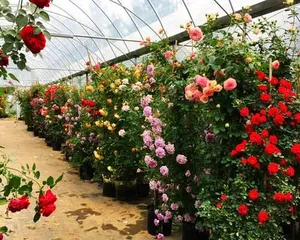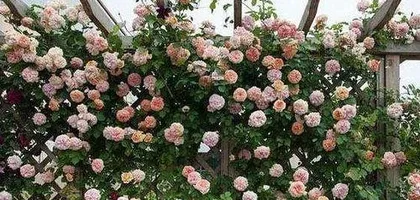Climbing roses are a beautiful type of flower that can bring us visual enjoyment. However, they can be challenging to care for. To help everyone better care for climbing roses, this article will provide a detailed introduction from aspects such as care techniques, growing environment, fertilization methods, and more.

Choose the right soil
Climbing roses prefer soft, well-draining soil. Therefore, before planting, you need to choose soil with a loose texture and add appropriate amounts of soft substances like leaf mold and perlite to increase the soil's aeration and water retention.
Pay attention to watering
Climbing roses need sufficient water during their growing period, but excessive watering can affect root health, so it's important to control the water. Generally, water once a week, and water again after the topsoil has dried slightly.

Avoid over-fertilizing
Although fertilizers greatly promote plant growth, excessive fertilization can also slow down growth and even cause diseases. Climbing roses need appropriate amounts of nitrogen, phosphorus, and potassium elements during their growing period, but it's also important to control the amount when fertilizing.
Pay attention to pruning
Climbing roses grow very fast and can easily become a dense mass of branches and leaves. To allow it to grow better, timely pruning of branches and leaves is necessary. Pruning is generally done in spring and autumn, which can promote its metabolism and enhance photosynthesis.
Likes light
Climbing roses prefer a well-lit environment, but direct sunlight is not suitable. It's best to avoid direct exposure during midday. During high summer temperatures, you can move it to a semi-shady place to prevent overheating.

Prevent and control pests and diseases
Climbing roses are susceptible to aphids and powdery mildew, so it is necessary to regularly spray insecticides and fungicides. At the same time, maintain good ventilation and avoid high-temperature and humid environments, which can effectively prevent the occurrence of pests and diseases.
Use a trellis
Climbing roses are a type of climbing plant that will climb onto a trellis during their growth period, so it is necessary to prepare a trellis for them. Generally, you can choose bamboo or wooden trellises, install them on the flower pot, and give the climbing rose enough space to grow.
Control temperature
Climbing roses are more adapted to mild climates, so it's important to control their growing temperature. In summer, it's best to move them to a semi-shady place, and in winter, the temperature needs to be kept above 5 degrees. Both too low and too high temperatures will affect their normal growth.
Avoid moving
Climbing roses prefer a stable growing environment and should not be moved frequently during their growth period. Each move will have a certain impact on its growth, and may even lead to slow growth or the occurrence of pests and diseases.
Pay attention to balanced nutrition
Climbing roses need appropriate fertilizers during their growing period, but also pay attention to balanced nutrition. Excessive amounts of a certain element will lead to a deficiency of other elements, which will affect its normal growth. Use comprehensive and balanced fertilizers and pay attention to the fertilization cycle and amount.
Prune moderately
During the growing period, climbing roses will continuously produce new branches and leaves, and the branches will become thicker and stronger. To control its growth direction and shape, moderate pruning is needed. During the growing period, you can prune branches and leaves as needed to promote its metabolism.
Maintain ventilation
Climbing roses like a well-ventilated environment and need to maintain good indoor ventilation during their growing period. In hot summer, you can open windows for ventilation, and in winter, pay attention to avoiding excessive indoor humidity. A good ventilation environment can promote its normal growth.
Pay attention to light duration
Climbing roses prefer a well-lit environment and have certain requirements for light duration. Generally, they need to receive at least 6 hours of light per day, otherwise it will affect their normal growth. In a dim environment, you can use lamps to help supplement the light.
Remove dead branches and leaves promptly
During the growing period, climbing roses will naturally wither some branches and leaves. Promptly removing dead branches and leaves can avoid adverse effects on their normal growth and prevent the breeding of pests and diseases.
Through the above introduction, I believe everyone has already understood how to care for climbing roses. In the process of care, you need to pay attention to choosing suitable soil, moderate watering, appropriate fertilization, regular pruning, using a trellis, controlling temperature, maintaining ventilation, paying attention to balanced nutrition, moderate pruning, and promptly removing dead branches and leaves. Only in this way can climbing roses grow healthily and vigorously.